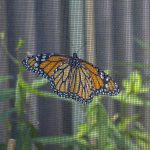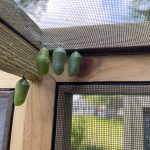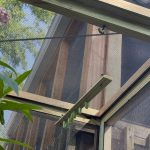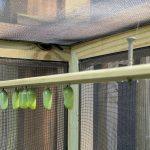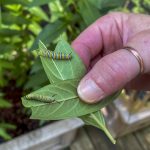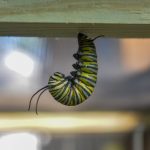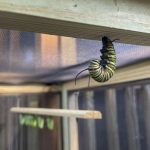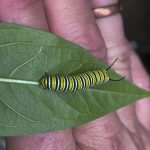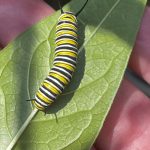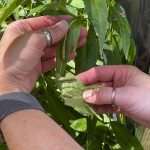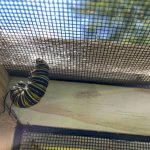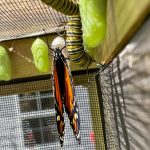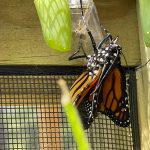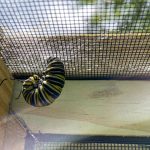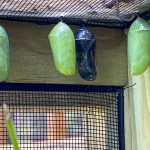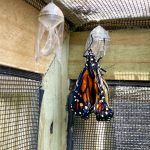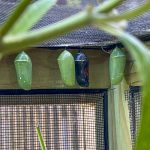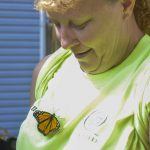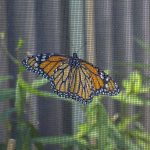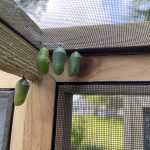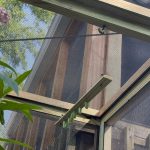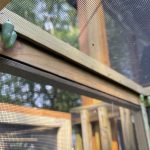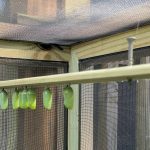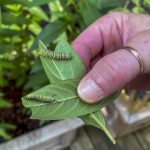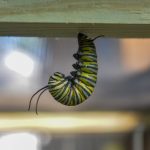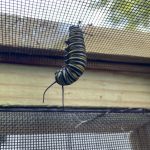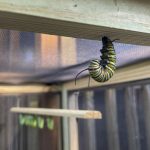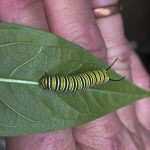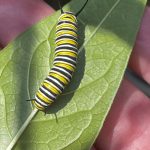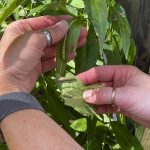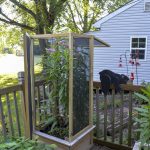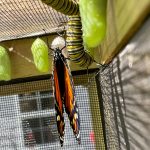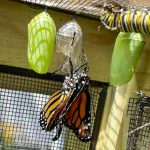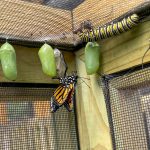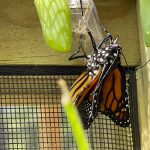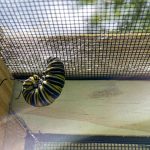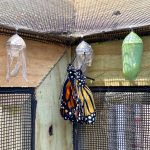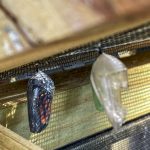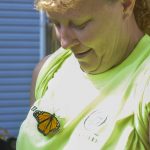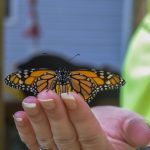Monarchs have a friend in Indiana
Story and photos by Abbie Gressley, Indiana Wildlife Federation 2021 Summer Habitat Intern
When Amanda Goble first started raising monarch butterflies three years ago, she only knew there weren’t many in her area. Little did she know the process she loves so much would soon be making a larger impact on the monarch population.
“I realize it is a small part to help, but any small thing could make a big impact eventually,” says the 46-year-old from Marion, Indiana.
The eastern migratory population of monarch butterflies decreased by 84% between the winters of 1996–1997 and 2014–2015, and the much smaller western monarch population has declined 74% since the late 1990s, according to the Indiana Monarch Conservation Plan (IMCP).
The IMCP was influenced by those interested in monarch butterfly conservation and habitat restoration in an attempt to reverse the population decline of North American monarchs.
Goble says they had almost lost monarchs in the area due to chemical spraying for bugs on crops and people using them at their own homes without the pollinators. So, she planted milkweed seeds for the monarchs to lay eggs on and had her husband build screened in cages to protect the caterpillars and cocoons from other bugs.
“I have an abundance of praying mantis in my yard, and they will eat them, so this gives them a safe place to stay in hopes that they will make it to butterflies,” she says.
Goble starts her process in the spring to make sure the milkweed is growing and plant more if needed. In July, the monarchs start showing up for nectar and begin laying eggs on the plants. She then watches for caterpillars and takes them to the cages to finish growing. It takes about fourteen to twenty days for them to eat before creating a J with their bodies and forming a cocoon. The cocoon will hatch within seven to nine days.
“Finding the caterpillars and letting the butterflies go is about all the hands-on work you need to do, the rest they do on their own,” Goble says. “I try not to interfere with their process too much.”
Goble says she loves the whole process and only wishes to help them grow to adulthood.
“I think it’s fascinating how an egg the size of a pinhead can grow to a caterpillar then change into a butterfly out of a small cocoon,” she says. “Watching them fly away is my favorite part; I say goodbye to each one and wish them well on their journey.”
According to the IMCP, Indiana, along with other Midwestern states, comprises a particularly important portion of the range of the eastern population of monarch butterflies, supplying much of the breeding and migrating habitat that produces the migratory generation of the eastern monarch population.
Goble is one of many in Indiana playing a small role for a much bigger cause for these butterflies.
“I just let the butterflies fly away in hopes that they will live to make new caterpillars and butterflies,” she says. “I hope to continue to give the butterflies a chance to survive and keep coming back to our area.”
- A monarch hatches August 2, 2021. It takes the monarch about three hours to dry its wings after hatching.
- Four cocoons hang in the corner of one of the cages July 28, 2021. One of the caterpillars just turned into a cocoon and is brighter green than the others.
- Many cocoons hang from a board Goble hangs from her cage July 28, 2021. The cocoons originally formed on a leaf that other caterpillars would eat through if left there.
- A caterpillar forms its J next to other cocoons July 28, 2021. The cages help keep other bugs from eating the caterpillars or cocoons.
- A caterpillar forms its J next to other cocoons July 28, 2021. The cages help keep other bugs from eating the caterpillars or cocoons.
- Many cocoons hang from a board Goble hangs from her cage July 28, 2021. The cocoons originally formed on a leaf that other caterpillars would eat through if left there.
- Goble shows multiple caterpillars on a leaf in one of her cages designed to keep them safe July 18, 2021. The caterpillars eat anywhere from fourteen to twenty before curving into a J and forming their cocoon.
- A caterpillar forms into a J July 28, 2021. The J is a sign that the caterpillar will soon form its cocoon.
- A caterpillar forms into a J July 28, 2021. The J is a sign that the caterpillar will soon form its cocoon.
- A caterpillar forms into a J July 28, 2021. The J is a sign that the caterpillar will soon form its cocoon.
- Goble shows a caterpillar on a leaf in one of her cages designed to keep them safe July 18, 2021. The caterpillars eat anywhere from fourteen to twenty before curving into a J and forming their cocoon.
- A tiny caterpillar on a leaf inside Goble’s cage July 18, 2021. The caterpillar recently hatched from its egg and begins eating the plants.
- Monarch egg on milkweed plant July 5, 2021. Once the eggs turn into caterpillars, Goble takes them to her cages so they can continue eating and growing.
- Monarch egg on milkweed plant July 5, 2021. Once the eggs turn into caterpillars, Goble takes them to her cages so they can continue eating and growing.
- Monarch egg on milkweed plant July 5, 2021. Once the eggs turn into caterpillars, Goble takes them to her cages so they can continue eating and growing.
- Goble shows a caterpillar on a leaf in one of her cages designed to keep them safe July 18, 2021. The caterpillars eat anywhere from fourteen to twenty before curving into a J and forming their cocoon.
- Goble shows small caterpillars on a leaf in one of her cages designed to keep them safe July 18, 2021. The caterpillars eat anywhere from fourteen to twenty before curving into a J and forming their cocoon.
- Goble shows small caterpillars on a leaf in one of her cages designed to keep them safe July 18, 2021. The caterpillars eat anywhere from fourteen to twenty before curving into a J and forming their cocoon.
- Goble checks on her caterpillars July 18, 2021. She brings many caterpillars to the cages daily from the milkweed plants.
- One of Goble’s cages she built for her monarch process. They are full of milkweed plants and have locks on them so the caterpillars cannot escape.
- Some of the plants Goble planted for her monarchs to lay eggs on. She has them all around her yard.
- Goble’s porch and set up for her monarchs. Majority of the plants are milkweed.
- Some of the plants Goble planted for her monarchs to lay eggs on. She has them all around her yard.
- One of Goble’s cages she built for her monarch process. They are full of milkweed plants and have locks on them so the caterpillars cannot escape.
- One of Goble’s cages she built for her monarch process. Her husband has built three of them for her.
- A caterpillar forms into a J July 28, 2021. The J is a sign that the caterpillar will soon form its cocoon.
- A monarch hatches August 2, 2021. It takes the cocoon about seven to nine days to hatch into a butterfly.
- A monarch hatches August 2, 2021. It takes the cocoon about seven to nine days to hatch into a butterfly.
- A monarch hatches August 2, 2021. It takes the cocoon about seven to nine days to hatch into a butterfly.
- A monarch hatches August 2, 2021. It takes the cocoon about seven to nine days to hatch into a butterfly.
- A caterpillar forms into a J July 28, 2021. The J is a sign that the caterpillar will soon form its cocoon.
- A monarch nears hatching August 2, 2021. The cocoons turn clear right before the butterfly hatches.
- A monarch hatches August 2, 2021. It takes the cocoon about seven to nine days to hatch into a butterfly.
- A monarch hatches August 2, 2021. It takes the cocoon about seven to nine days to hatch into a butterfly.
- A monarch nears hatching August 2, 2021. The cocoons turn clear right before the butterfly hatches.
- A monarch nears hatching August 2, 2021. The cocoons turn clear right before the butterfly hatches.
- Goble and her husband check on the caterpillars July 18, 2021. They watch the caterpillars daily and continue to wait for the monarchs to hatch.
- Sarah Goble in front of her monarch cages August 2, 2021. She has been raising monarchs for three years.
- Goble watches as the monarch lands on her right before flying away August 2, 2021. The monarchs usually stick around for awhile before completely flying away.
- Goble holds the newly hatched monarch August 2, 2021. She waited about three hours to release the monarch from the cage in order for its wings to dry.
- A monarch hatches August 2, 2021. It takes the monarch about three hours to dry its wings after hatching.
- Four cocoons hang in the corner of one of the cages July 28, 2021. One of the caterpillars just turned into a cocoon and is brighter green than the others.
- Many cocoons hang from a board Goble hangs from her cage July 28, 2021. The cocoons originally formed on a leaf that other caterpillars would eat through if left there.
- A caterpillar forms its J next to other cocoons July 28, 2021. The cages help keep other bugs from eating the caterpillars or cocoons.
- A caterpillar forms its J next to other cocoons July 28, 2021. The cages help keep other bugs from eating the caterpillars or cocoons.
- Many cocoons hang from a board Goble hangs from her cage July 28, 2021. The cocoons originally formed on a leaf that other caterpillars would eat through if left there.
- Goble shows multiple caterpillars on a leaf in one of her cages designed to keep them safe July 18, 2021. The caterpillars eat anywhere from fourteen to twenty before curving into a J and forming their cocoon.
- A caterpillar forms into a J July 28, 2021. The J is a sign that the caterpillar will soon form its cocoon.
- A caterpillar forms into a J July 28, 2021. The J is a sign that the caterpillar will soon form its cocoon.
- A caterpillar forms into a J July 28, 2021. The J is a sign that the caterpillar will soon form its cocoon.
- Goble shows a caterpillar on a leaf in one of her cages designed to keep them safe July 18, 2021. The caterpillars eat anywhere from fourteen to twenty before curving into a J and forming their cocoon.
- A tiny caterpillar on a leaf inside Goble’s cage July 18, 2021. The caterpillar recently hatched from its egg and begins eating the plants.
- Monarch egg on milkweed plant July 5, 2021. Once the eggs turn into caterpillars, Goble takes them to her cages so they can continue eating and growing.
- Monarch egg on milkweed plant July 5, 2021. Once the eggs turn into caterpillars, Goble takes them to her cages so they can continue eating and growing.
- Monarch egg on milkweed plant July 5, 2021. Once the eggs turn into caterpillars, Goble takes them to her cages so they can continue eating and growing.
- Goble shows a caterpillar on a leaf in one of her cages designed to keep them safe July 18, 2021. The caterpillars eat anywhere from fourteen to twenty before curving into a J and forming their cocoon.
- Goble shows small caterpillars on a leaf in one of her cages designed to keep them safe July 18, 2021. The caterpillars eat anywhere from fourteen to twenty before curving into a J and forming their cocoon.
- Goble shows small caterpillars on a leaf in one of her cages designed to keep them safe July 18, 2021. The caterpillars eat anywhere from fourteen to twenty before curving into a J and forming their cocoon.
- Goble checks on her caterpillars July 18, 2021. She brings many caterpillars to the cages daily from the milkweed plants.
- One of Goble’s cages she built for her monarch process. They are full of milkweed plants and have locks on them so the caterpillars cannot escape.
- Some of the plants Goble planted for her monarchs to lay eggs on. She has them all around her yard.
- Goble’s porch and set up for her monarchs. Majority of the plants are milkweed.
- Some of the plants Goble planted for her monarchs to lay eggs on. She has them all around her yard.
- One of Goble’s cages she built for her monarch process. They are full of milkweed plants and have locks on them so the caterpillars cannot escape.
- One of Goble’s cages she built for her monarch process. Her husband has built three of them for her.
- A caterpillar forms into a J July 28, 2021. The J is a sign that the caterpillar will soon form its cocoon.
- A monarch hatches August 2, 2021. It takes the cocoon about seven to nine days to hatch into a butterfly.
- A monarch hatches August 2, 2021. It takes the cocoon about seven to nine days to hatch into a butterfly.
- A monarch hatches August 2, 2021. It takes the cocoon about seven to nine days to hatch into a butterfly.
- A monarch hatches August 2, 2021. It takes the cocoon about seven to nine days to hatch into a butterfly.
- A caterpillar forms into a J July 28, 2021. The J is a sign that the caterpillar will soon form its cocoon.
- A monarch nears hatching August 2, 2021. The cocoons turn clear right before the butterfly hatches.
- A monarch hatches August 2, 2021. It takes the cocoon about seven to nine days to hatch into a butterfly.
- A monarch hatches August 2, 2021. It takes the cocoon about seven to nine days to hatch into a butterfly.
- A monarch nears hatching August 2, 2021. The cocoons turn clear right before the butterfly hatches.
- A monarch nears hatching August 2, 2021. The cocoons turn clear right before the butterfly hatches.
- Goble and her husband check on the caterpillars July 18, 2021. They watch the caterpillars daily and continue to wait for the monarchs to hatch.
- Sarah Goble in front of her monarch cages August 2, 2021. She has been raising monarchs for three years.
- Goble watches as the monarch lands on her right before flying away August 2, 2021. The monarchs usually stick around for awhile before completely flying away.
- Goble holds the newly hatched monarch August 2, 2021. She waited about three hours to release the monarch from the cage in order for its wings to dry.


